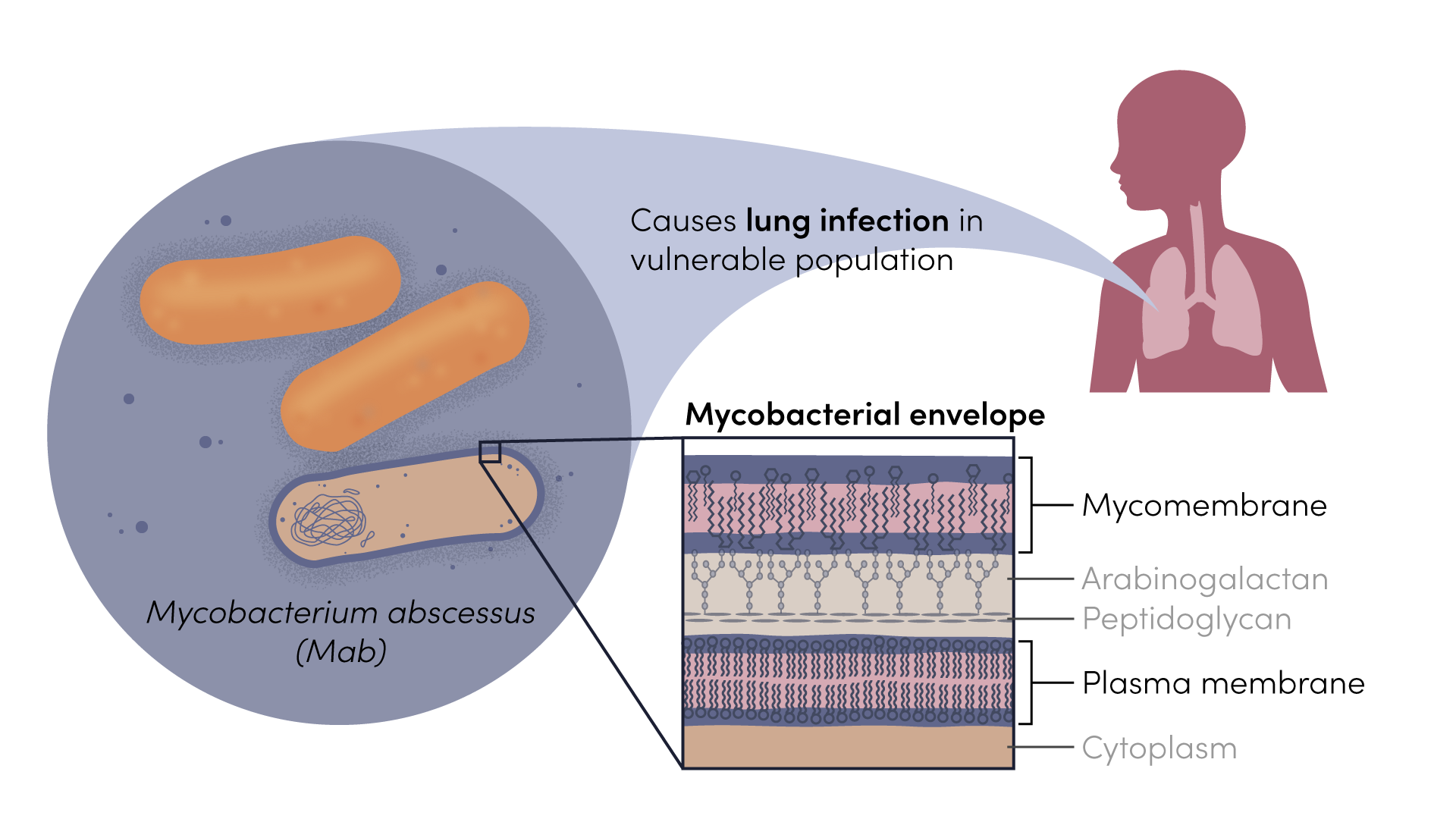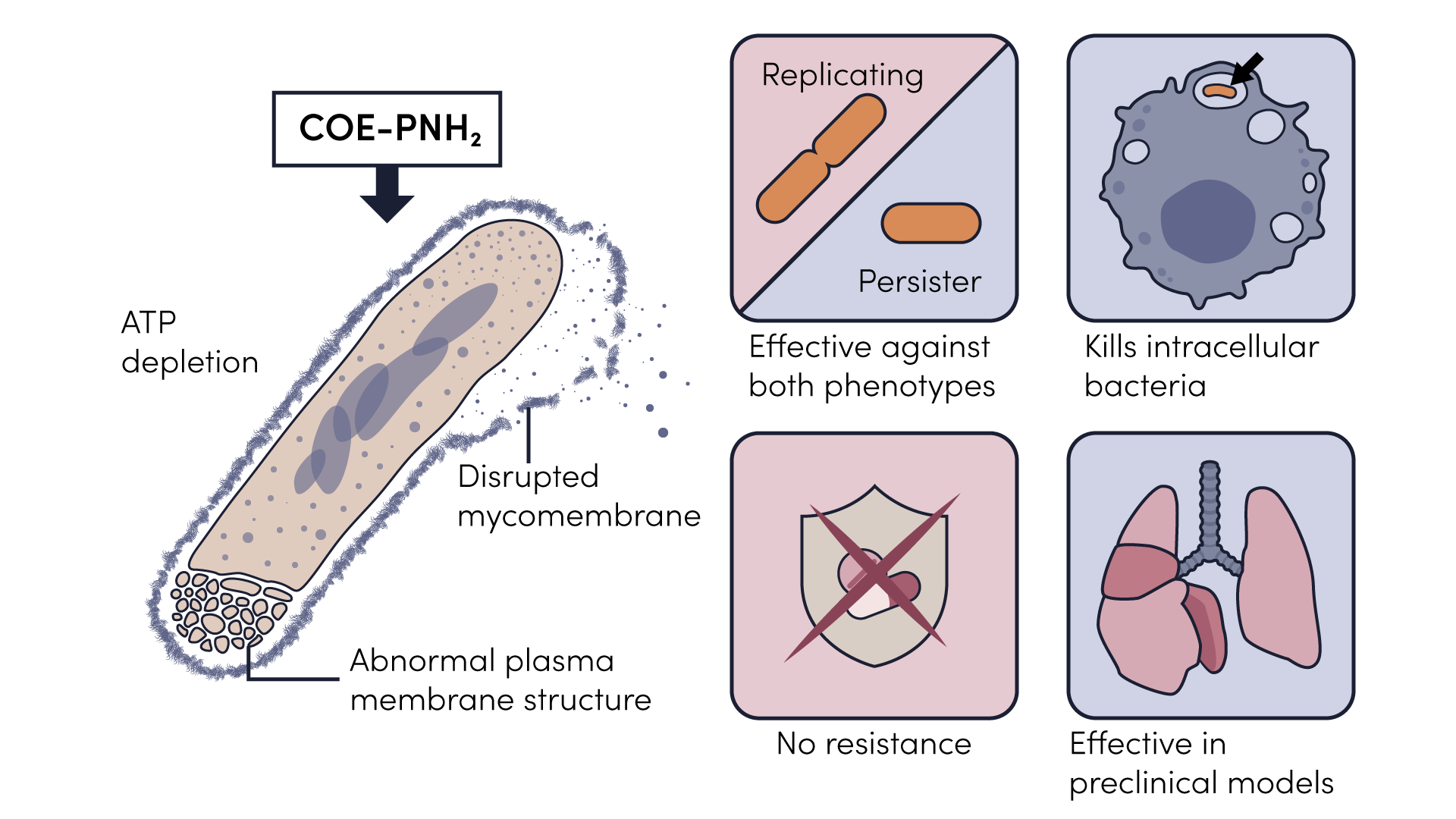Antimicrobial resistance (AMR) has been described as one of the most significant public health threats of our age. In 2019 alone, over 5 million deaths were attributed to antibiotic-resistant infections. [1]
Mycobacterium abscessus (Mab) is a species of nontuberculous mycobacteria that is commonly associated with AMR. It is responsible for chronic lung infections with limited therapeutic options for their treatment. Current regimens used to treat Mab are largely empirical and their efficacy is often unproven. The Infectious Diseases Society of America recommends long-term treatment (minimum 1.5 years) using drugs that are also associated with notable adverse side effects. In view that Mab infections are rapidly growing, additional therapeutics are needed, and this means identifying novel drug targets and agents.

Developing drugs that can disrupt the structure and composition of the mycobacterial envelope of Mab is crucial for developing new treatment strategies and combating antimicrobial resistance.
Stepping up to this challenge, Professor Guillermo Bazan from NUS Chemistry and Institute for Functional Intelligent Materials (I-FIM), has employed machine learning-based approaches to aid in the search for novel therapeutic options against hard-to-treat diseases like Mab infections. One potential compound identified in their search is COE-PNH
2, a conjugated oligoelectrolyte (COE) with cationic side groups. This work was recently published in
Science Translational Medicine.

Chemical structure of COE-PNH2 with identification of structural units with different physicochemical properties.
COE is a class of small amphiphilic (hydrophilic-hydrophobic-hydrophilic) molecules that share a modular structure that can spontaneously interact with lipid bilayers in biological membranes. With the molecular design and synthesis being relatively simple processes, a spectrum of bacterial interfacing synthetic compounds can easily be constructed using the COE platform.
COE-PNH2 is believed to target the mycobacterial envelope - a structural membrane surrounding Mab cells. The mycobacterial envelope must be functionally intact for the bacteria to survive, and as such, compounds that specifically target this membrane display rapid bactericidal activity regardless of the metabolic state of the bacteria.
To fully characterise COE-PNH2, Bazan and colleagues synthesised the molecule and evaluated its antibacterial activity against different forms of Mab, assessed its cytotoxicity profile against mammalian cells, and determined the propensity of bacteria to develop resistance.

Antibacterial activity COE-PNH2 against Mab without being cytotoxic towards eukaryotic cells.
Antibacterial activity of COE-PNH2
After exposing Mab cells to COE-PNH2, a change in the morphology of the mycobacterial cell envelope was observed. This was attributed to a two-pronged interaction of COE-PNH2 with the mycomembrane and plasma membrane. As this mode of action targets the physical and functional integrity of the bacterial envelope rather than specific enzymes, it can result in a lower likelihood of spontaneous mutations or the development of resistance by the bacteria, compared to antibiotics that target specific enzymes or pathways. This indicates the potential of COE-PNH2 as a novel antimicrobial agent with a reduced risk of resistance development.
Prof Bazan and his team also conducted kill-kinetics experiments, which are studies that assess the rate and extent of microbial killing by antimicrobial agents over time, to evaluate the bactericidal activity of COE-PNH2. It was found that at a concentration of 128 μg/ml, COE-PNH2 completely eradicates the bacteria, a feat that common antibiotics like amikacin (AMK) and linezolid (LZD) cannot achieve at this concentration.
The presence of bacteria cells that resist treatment, also known as persisters, is a common complication with antibiotic treatment and can cause the relapse of infection if these cells are not exterminated. In this study, the team found that COE-PNH2 was able to eradicate Mab persisters at a relatively low concentration, which is not possible with common antibiotics even at a higher concentration.
Beyond extracellular activities, Mab can invade phagocytic cells, a type of immune cell, and persist intracellularly. This is a challenge to many first-line antibiotics as they have limited penetration into mammalian cells, and therefore have a reduced efficacy on the intracellular Mab. Prof Bazan’s team found that COE-PNH2 was able to penetrate macrophages and eliminate intracellular Mab effectively.
Altogether, the results show that COE-PNH2 is able to comprehensively eradicate the Mab bacteria, without leaving behind a niche for relapse of infection.
Safety and efficacy of COE-PNH2
Membrane-disrupting compounds often display indiscriminate toxicity to mammalian cells and red blood cells due to their amphiphilic nature, however, experiments revealed that COE-PNH2 is well-tolerated under conditions similar to human blood where there is the potential for interference by substances such as enzymes, salts, and proteins. Importantly, it was found that COE-PNH2 retained its bactericidal activity, thereby confirming the robustness of its antimicrobial activity.
Finally, the team assessed each element investigated in vitro in an in vivo model. This was done in collaboration with Prof Kevin Pethe from the Lee Kong Chian School of Medicine at the Nanyang Technological University. These experiments revealed that COE-PNH2 was well-tolerated and efficacious in the preclinical models. In fact, the efficacy of COE-PNH2 was superior to what was observed with AMK, which is currently widely used in clinical treatments.
In summary, Bazan and colleagues developed a safe and efficacious small-molecule drug against Mab based on the COE platform. The lead compound COE-PNH2 demonstrates high potency toward Mab and an improved safety margin over previously studied COEs. It targets the integrity and functionality of the mycobacterial envelope, which endows its low propensity for resistance development and robust bactericidal activity. Altogether, this study highlights the therapeutic potential of membrane-targeting COEs as potent anti-Mab candidates. As COE is a relatively new antibiotic platform, the researchers will characterise the mechanism of action, so as to further guide molecular design in the continued optimisation of the COE scaffold.
References
[1]
C. J. Murray, K. S. Ikuta, F. Sharara, L. Swetschinski, G. R. Aguilar, A. Gray, C. Han, C. Bisignano, P. Rao, E. Wool, Global burden of bacterial antimicrobial resistance in 2019: A systematic analysis. Lancet 399, 629–655 (2022).
[2]
Zhang, K., Limwongyut, J., Moreland, A. S., Wei, S. C. J., Jim Jia Min, T., Sun, Y., ... & Bazan, G. C. (2024). An anti-mycobacterial conjugated oligoelectrolyte effective against Mycobacterium abscessus. Science Translational Medicine, 16(735), eadi7558.
